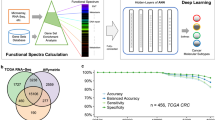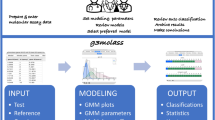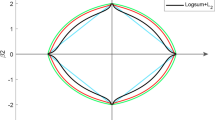Abstract
Background
Cancer is a heterogeneous disease driven by complex molecular alterations. Cancer subtypes determined from multi-omics data can provide novel insight into personalised precision treatment. It is recognised that incorporating prior weight knowledge into multi-omics data integration can improve disease subtyping.
Methods
We develop a weighted method, termed weight-boosted Multi-Kernel Learning (wMKL) which incorporates heterogeneous data types as well as flexible weight functions, to boost subtype identification. Given a series of weight functions, we propose an omnibus combination strategy to integrate different weight-related P-values to improve subtyping precision.
Results
wMKL models each data type with multiple kernel choices, thus alleviating the sensitivity and robustness issue due to selecting kernel parameters. Furthermore, wMKL integrates different data types by learning weights of different kernels derived from each data type, recognising the heterogeneous contribution of different data types to the final subtyping performance. The proposed wMKL outperforms existing weighted and non-weighted methods. The utility and advantage of wMKL are illustrated through extensive simulations and applications to two TCGA datasets. Novel subtypes are identified followed by extensive downstream bioinformatics analysis to understand the molecular mechanisms differentiating different subtypes.
Conclusions
The proposed wMKL method provides a novel strategy for disease subtyping. The wMKL is freely available at https://github.com/biostatcao/wMKL.
This is a preview of subscription content, access via your institution
Access options
Subscribe to this journal
Receive 24 print issues and online access
$259.00 per year
only $10.79 per issue
Buy this article
- Purchase on Springer Link
- Instant access to full article PDF
Prices may be subject to local taxes which are calculated during checkout




Similar content being viewed by others
Data availability
The TCGA data analysed in this study can be accessed through the Genomic Data Commons Data Portal (http://cancergenome.nih.gov/). The wMKL is implemented in the R package wMKL, freely available on GitHub (https://github.com/biostatcao/wMKL).
References
Rappoport N, Shamir R. Multi-omic and multi-view clustering algorithms: review and cancer benchmark. Nucleic Acids Res. 2018;46:10546–62.
Wu D, Wang D, Zhang MQ, Gu J. Fast dimension reduction and integrative clustering of multi-omics data using low-rank approximation: application to cancer molecular classification. BMC Genom. 2015;16:1022.
Nguyen T, Tagett R, Diaz D, Draghici S. A novel approach for data integration and disease subtyping. Genome Res. 2017;27:2025–39.
Wang B, Mezlini AM, Demir F, Fiume M, Tu Z, Brudno M, et al. Similarity network fusion for aggregating data types on a genomic scale. Nat Method. 2014;11:333.
Speicher NK, Pfeifer N. Integrating different data types by regularized unsupervised multiple kernel learning with application to cancer subtype discovery. Bioinformatics. 2015;31:i268–75.
Röder B, Kersten N, Herr M, Speicher NK, Pfeifer N. web-rMKL: a web server for dimensionality reduction and sample clustering of multi-view data based on unsupervised multiple kernel learning. Nucleic Acids Res. 2019;47:W605–09.
Lock EF, Hoadley KA, Marron JS, Nobel AB. Joint and individual variation explained (JIVE) for integrated analysis of multiple data types. Ann Appl Stat. 2013;7:523.
Shen R, Olshen AB, Ladanyi M. Integrative clustering of multiple genomic data types using a joint latent variable model with application to breast and lung cancer subtype analysis. Bioinformatics. 2009;25:2906–12.
Ramazzotti D, Lal A, Wang B, Batzoglou S, Sidow A. Multi-omic tumor data reveal diversity of molecular mechanisms that correlate with survival. Nat Commun. 2018;9:1–14.
Xu T, Le TD, Liu L, Wang R, Sun B, Li J. Identifying cancer subtypes from miRNA-tf-mRNA regulatory networks and expression data. PLoS ONE. 2016;11:e0152792.
Ruan P, Wang Y, Shen R, Wang S. Using association signal annotations to boost similarity network fusion. Bioinformatics. 2019;35:3718–26.
Coretto P, Serra A, Tagliaferri R. Robust clustering of noisy high-dimensional gene expression data for patients subtyping. Bioinformatics. 2018;34:4064–72.
Arora A, Olshen AB, Seshan VE, Shen R. Pan-cancer identification of clinically relevant genomic subtypes using outcome-weighted integrative clustering. Genome Med. 2020;12:1–13.
Wang B, Zhu J, Pierson E, Ramazzotti D, Batzoglou S. Visualization and analysis of single-cell RNA-seq data by kernel-based similarity learning. Nat Method. 2017;14:414–6.
Liu Y, Xie J. Cauchy combination test: a powerful test with analytic p-value calculation under arbitrary dependency structures. J Am Stat Assoc. 2020;115:393–402.
Ng A, Jordan M, Weiss Y. On spectral clustering: analysis and an algorithm. Adv Neural Inf Process Syst. 2002;14:849–56.
Von Luxburg U. A tutorial on spectral clustering. Stat Comput. 2007;17:395–416.
Xu A, Chen J, Peng H, Han G, Cai H. Simultaneous interrogation of cancer omics to identify subtypes with significant clinical differences. Front Genet. 2019;10:236.
Shi Q, Zhang C, Peng M, Yu X, Zeng T, Liu J, et al. Pattern fusion analysis by adaptive alignment of multiple heterogeneous omics data. Bioinformatics. 2017;33:2706–14.
Conway K, Edmiston SN, Tse CK, Bryant C, Kuan PF, Hair BY, et al. Racial variation in breast tumor promoter methylation in the Carolina Breast Cancer Study. Cancer Epidemiol Prev Biomark. 2015;24:921–30.
Shimomura A, Shiino S, Kawauchi J, Takizawa S, Sakamoto H, Matsuzaki J, et al. Novel combination of serum microRNA for detecting breast cancer in the early stage. Cancer Sci. 2016;107:326–34.
Nakagawa T, Kollmeyer TM, Morlan BW, Anderson SK, Bergstralh EJ, Davis BJ, et al. A tissue biomarker panel predicting systemic progression after PSA recurrence post-definitive prostate cancer therapy. PLoS ONE. 2008;3:e2318.
Colaprico A, Silva TC, Olsen C, Garofano L, Cava C, Garolini D, et al. TCGAbiolinks: an R/Bioconductor package for integrative analysis of TCGA data. Nucleic Acids Res. 2016;44:e71.
Gusev A, Lee SH, Trynka G, Finucane H, Vilhjálmsson BJ, Xu H, et al. Partitioning heritability of regulatory and cell-type-specific variants across 11 common diseases. Am J Hum Genet. 2014;95:535–52.
Troyanskaya O, Cantor M, Sherlock G, Brown P, Hastie T, Tibshirani R, et al. Missing value estimation methods for DNA microarrays. Bioinformatics. 2001;17:520–5.
Yang H, Cao H, He T, Wang T, Cui Y. Multilevel heterogeneous omics data integration with kernel fusion. Brief Bioinformatics. 2020;21:156–70.
Witten DM, Tibshirani R, Hastie T. A penalized matrix decomposition, with applications to sparse principal components and canonical correlation analysis. Biostatistics. 2009;10:515–34.
Oliveros JC (2007–2015). Venny. An interactive tool for comparing lists with Venn’s diagrams, https://bioinfogp.cnb.csic.es/tools/venny/index.html. 2007–2015
Huang HY, Lin YC, Li J, Huang KY, Shrestha S, Hong HC, et al. miRTarBase 2020: updates to the experimentally validated microRNA–target interaction database. Nucleic Acids Res. 2020;48:D148–54.
Schubert M, Klinger B, Klünemann M, Sieber A, Uhlitz F, Sauer S, et al. Perturbation-response genes reveal signaling footprints in cancer gene expression. Nat Commun. 2018;9:20.
Li T, Fu J, Zeng Z, Cohen D, Li J, Chen Q, et al. TIMER2.0 for analysis of tumor-infiltrating immune cells. Nucleic Acids Res. 2020;48:W509–14.
Xie C, Mao X, Huang J, Ding Y, Wu J, Dong S, et al. KOBAS 2.0: a web server for annotation and identification of enriched pathways and diseases. Nucleic Acids Res. 2011;39:W316–22.
Cancer Genome Atlas Research Network. Comprehensive molecular characterization of papillary renal-cell carcinoma. N Engl J Med. 2016;374:135–45.
Krawczyk KM, Nilsson H, Allaoui R, Lindgren D, Arvidsson M, Leandersson K, et al. Papillary renal cell carcinoma-derived chemerin, IL-8, and CXCL16 promote monocyte recruitment and differentiation into foam-cell macrophages. Lab Investig. 2017;97:1296–305.
Singh NP, Vinod P. Integrative analysis of DNA methylation and gene expression in papillary renal cell carcinoma. Mol Genet Genom. 2020;295:807–24.
Khella H, Bakhet M, Allo G, Jewett M, Girgis A, Latif A, et al. miR-192, miR-194 and miR-215: a convergent microRNA network suppressing tumor progression in renal cell carcinoma. Carcinogenesis. 2013;34:2231–9.
Chen SC, Chen FW, Hsu YL, Kuo PL. Systematic analysis of transcriptomic profile of renal cell carcinoma under long-term hypoxia using next-generation sequencing and bioinformatics. Int J Mol Sci. 2017;18:2657.
Huang D, Ding Y, Luo WM, Bender S, Qian CN, Kort E, et al. Inhibition of MAPK kinase signaling pathways suppressed renal cell carcinoma growth and angiogenesis in vivo. Cancer Res. 2008;68:81–8.
Courthod G, Tucci M, Di Maio M, Scagliotti GV. Papillary renal cell carcinoma: a review of the current therapeutic landscape. Crit Rev Oncol/Hematol. 2015;96:100–12.
Twardowski PW, Mack PC, Lara PN Jr. Papillary renal cell carcinoma: current progress and future directions. Clin Genitourin Cancer. 2014;12:74–9.
Mizutani Y, Nakanishi H, Yoshida O, Fukushima M, Bonavida B, Miki T. Potentiation of the sensitivity of renal cell carcinoma cells to TRAIL-mediated apoptosis by subtoxic concentrations of 5-fluorouracil. Eur J Cancer. 2002;38:167–76.
Thorburn A. Tumor necrosis factor-related apoptosis-inducing ligand (TRAIL) pathway signaling. J Thorac Oncol. 2007;2:461–5.
Braun DA, Hou Y, Bakouny Z, Ficial M, Sant’Angelo M, Forman J, et al. Interplay of somatic alterations and immune infiltration modulates response to PD-1 blockade in advanced clear cell renal cell carcinoma. Nat Med. 2020;26:909–18.
Wang M, Zhang C, Song Y, Wang Z, Wang Y, Luo F, et al. Mechanism of immune evasion in breast cancer. Onco Targets Ther. 2017;10:1561.
Feng H, Zhang Y, Liu K, Zhu Y, Yang Z, Zhang X, et al. Intrinsic gene changes determine the successful establishment of stable renal cancer cell lines from tumor tissue. Int J Cancer. 2017;140:2526–34.
Cao Y, Hoeppner LH, Bach S, Guangqi E, Guo Y, Wang E, et al. Neuropilin-2 promotes extravasation and metastasis by interacting with endothelial α5 integrin. Cancer Res. 2013;73:4579–90.
Braga EA, Fridman MV, Loginov VI, Dmitriev AA, Morozov SG. Molecular mechanisms in clear cell renal cell carcinoma: role of miRNAs and hypermethylated miRNA genes in crucial oncogenic pathways and processes. Front Genet. 2019;10:320.
Drake RR, McDowell C, West C, David F, Powers TW, Nowling T, et al. Defining the human kidney N‐glycome in normal and cancer tissues using MALDI imaging mass spectrometry. J Mass Spectrom. 2020;55:e4490.
Sung H, Ferlay J, Siegel RL, Laversanne M, Soerjomataram I, Jemal A, et al. Global cancer statistics 2020: GLOBOCAN estimates of incidence and mortality worldwide for 36 cancers in 185 countries. Cancer J Clin. 2021;71:209–49.
Cancer Genome Atlas Research Network. Comprehensive molecular profiling of lung adenocarcinoma. Nature. 2014;511:543–50.
Wilkerson MD, Yin X, Walter V, Zhao N, Cabanski CR, Hayward MC, et al. Differential pathogenesis of lung adenocarcinoma subtypes involving sequence mutations, copy number, chromosomal instability, and methylation. PLoS ONE. 2012;7:e36530.
Denisenko TV, Budkevich IN, Zhivotovsky B. Cell death-based treatment of lung adenocarcinoma. Cell Death Dis. 2018;9:117.
Xu F, Chen J, Yang X, Hong X, Li Z, Lin L, et al. Analysis of lung adenocarcinoma subtypes based on immune signatures identifies clinical implications for cancer therapy. Mol Ther Oncolytics. 2020;17:241–9.
Yan J, Ma C, Gao Y. MicroRNA-30a-5p suppresses epithelial-mesenchymal transition by targeting profilin-2 in high invasive non-small cell lung cancer cell lines. Oncol Rep. 2017;37:3146–54.
Fruman DA, Chiu H, Hopkins BD, Bagrodia S, Cantley LC, Abraham RT. The PI3K pathway in human disease. Cell. 2017;170:605–35.
Wang JB, Huang X, Li FR. Impaired dendritic cell functions in lung cancer: a review of recent advances and future perspectives. Cancer Commun. 2019;39:43.
Gao X, Zhang Y, Saum KU, Schöttker B, Breitling LP, Brenner H. Tobacco smoking and smoking-related DNA methylation are associated with the development of frailty among older adults. Epigenetics. 2017;12:149–56.
Cho WC, Chow AS, Au JS. MiR-145 inhibits cell proliferation of human lung adenocarcinoma by targeting EGFR and NUDT1. RNA Biol. 2011;8:125–31.
Flamini V, Dudley E, Jiang WG, Cui Y. Distinct mechanisms by which two forms of miR-140 suppress the malignant properties of lung cancer cells. Oncotarget. 2018;9:36474–91.
Han LK, Huai QL, Guo W, Song P, Kong DM, Gao SG, et al. Identification of prognostic genes in lung adenocarcinoma immune microenvironment. Chin Med J. 2021;134:2125–7.
Lin N, Yao Z, Xu M, Chen J, Lu Y, Yuan L, et al. Long noncoding RNA MALAT1 potentiates growth and inhibits senescence by antagonizing ABI3BP in gallbladder cancer cells. J Exp Clin Cancer Res. 2019;38:244.
Morello V, Cabodi S, Sigismund S, Camacho-Leal M, Repetto D, Volante M, et al. β1 integrin controls EGFR signaling and tumorigenic properties of lung cancer cells. Oncogene. 2011;30:4087–96.
Pasternack H, Kuempers C, Deng M, Watermann I, Olchers T, Kuehnel M, et al. Identification of molecular signatures associated with early relapse after complete resection of lung adenocarcinomas. Sci Rep. 2021;11:9532.
Wu J, Zhou J, Xu Q, Foley R, Guo J, Zhang X, et al. Identification of key genes driving tumor associated macrophage migration and polarization based on immune fingerprints of lung adenocarcinoma. Front Cell Dev Biol. 2021;9:751800.
Zhao Z, He B, Cai Q, Zhang P, Peng X, Zhang Y, et al. Combination of tumor mutation burden and immune infiltrates for the prognosis of lung adenocarcinoma. Int Immunopharmacol. 2021;98:107807.
Luo J, Liu Z. Long non-coding RNA TTN-AS1 promotes the progression of lung adenocarcinoma by regulating PTEN/PI3K/AKT signaling pathway. Biochem Biophys Res Commun. 2019;514:140–7.
Acknowledgements
The authors would like to express their gratitude to an associate editor and three anonymous reviewers for their valuable insights and constructive feedback, which significantly contributed to the enhancement of this paper.
Funding
HC was supported by the National Natural Science Foundation of China (71403156), the Fundamental Research Programme of Shanxi Province (202303021211130), China Scholarship Council (No.201908140151), Startup Foundation for Doctors of Shanxi Medical University (BS201722). HY was supported by the National Natural Science Foundation of China (81872717). YC was supported by the Michigan State University.
Author information
Authors and Affiliations
Contributions
HC and YC designed the study; HC performed simulations and real data analysis with assistance from CJ, ZL, HY, YZ and YC; HC developed the software tool with assistance from RF; HC and YC wrote the manuscript with input from all other authors. All authors reviewed and approved the final manuscript.
Corresponding author
Ethics declarations
Competing interests
The authors declare no competing interests.
Ethics approval and consent to participate
Not applicable.
Additional information
Publisher’s note Springer Nature remains neutral with regard to jurisdictional claims in published maps and institutional affiliations.
Supplementary information
Rights and permissions
Springer Nature or its licensor (e.g. a society or other partner) holds exclusive rights to this article under a publishing agreement with the author(s) or other rightsholder(s); author self-archiving of the accepted manuscript version of this article is solely governed by the terms of such publishing agreement and applicable law.
About this article
Cite this article
Cao, H., Jia, C., Li, Z. et al. wMKL: multi-omics data integration enables novel cancer subtype identification via weight-boosted multi-kernel learning. Br J Cancer 130, 1001–1012 (2024). https://doi.org/10.1038/s41416-024-02587-w
Received:
Revised:
Accepted:
Published:
Issue Date:
DOI: https://doi.org/10.1038/s41416-024-02587-w



